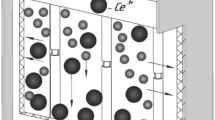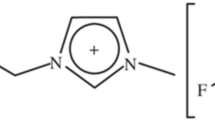Abstract
The current variation effect in an electrochemical cell (ECC) with deionized water is considered. It is shown that current variations result from formation of electrophoretic current of charged nanoparticles in the electric field of the cell. Influence of the field concentrator on current variations in a two-electrode ECC with deionized water is examined. A mechanism is proposed which explains enhancement of ECC water sensitivity to exposures by formation of nano-sized metal particles.



Similar content being viewed by others
Notes
Similar current “treatment” of the ECC for purification is often used in electrochemistry.
SHE = standard hydrogen electrode.
Colloidal compounds of iron and chromium are widely used for creating various magnetic carriers and for magnetic separation in modern immunoanalyzers [22].
REFERENCES
B. M. Vladimirskii, Cosmic Weather and the Biosphere: History of Research and the Present Time (URSS, Moscow, 2017) [in Russian].
B. M. Vladimirsky, “Space-weather variations as a probable cause of the appearance of artifacts in accurate measurements,” Izv., Atmos. Oceanic Phys. 55 (11), 1629–1638 (2019). https://doi.org/10.1134/S0001433819110197
V. Ya. Antonchenko, A. S. Davydov, and V. V. Il’in, Basics of Water Physics (Naukova Dumka, Kiev, 1991) [in Russian].
D. Eisenberg and W. Kauzmann, The Structure and Properties of Water (Clarendon, Oxford, 1969).
G. H. Pollack, The Fourth Phase of Water: Beyond Solid, Liquid, and Vapor (Ebner, Seattle, WA, 2013).
V. V. Tsetlin, “Studies into water reactions to variations of cosmophysical and geophysical factors of the environment,” Aviakosm. Ekol. Med. 44 (6), 26–30 (2010) [in Russian]. https://elibrary.ru/item.asp?id=20356935
V. E. Kasatkin, D. L. Tytik, A. A. Revina, S. A. Busev, M. A. Abaturov, V. V. Vysotskii, V. I. Roldugin, L. P. Kazanskii, V. I. Kuz’min, A. F. Gadzaov, and V. V. Tsetlin, “Electrochemical synthesis of iron and platinum nanoparticles in deionized water,” Prot. Met. Phys. Chem. Surf. 51 (6), 973–979 (2015). https://doi.org/10.1134/S207020511506012X
V. V. Zelenkov, I. K. Zudin, L. D. Mironov, and F. F. Kharlamov, RF Patent No. 2154870, Bull. Izobret., No. 23 (2000).
J. Barek and J. Zima, “Eighty years of polarography – history and future,” Electroanalysis 15 (5-6), 467–472 (2003). https://doi.org/10.1002/elan.200390055
A. N. Frumkin, Adsorption and Oxidative Processes (Akad. Nauk SSSR, Moscow, 1951), vol. 4 [in Russian].
A. N. Frumkin, Electrode Processes. Selected Works (Nauka, Moscow, 1987) [in Russian].
N. A. Bach and N. A. Balashova, “Electrochemistry of platinum sols. I. Preparation of ash,” Zh. Fiz. Khim. 5 (1), 43–53 (1936) [in Russian].
N. A. Bach and N. A. Balashova, “Electrochemistry of platinum sols. III. Positive platinum sols,” Zh. Fiz. Khim. 10 (4-5), 575–585 (1937) [in Russian].
A. N. Frumkin and A. I. Shlygin, “About the platinum electrode,” Dokl. Akad. Nauk SSSR 2 (3), 173–179 (1934) [in Russian].
H. Tsubomura and R. S. Mulliken, “Molecular complexes and their spectra. XII. Ultraviolet absorption spectra caused by the interaction of oxygen with organic molecules,” J. Am. Chem. Soc. 82 (23), 5966–5974 (1960). https://doi.org/10.1021/ja01508a002
R. S. Mulliken and W. B. Person, Molecular Complexes (Wiley, New York, 1969).
A. A. Revina and N. A. Bach, “Investigation of the interaction of molecular oxygen with a stable free radical in solution by the method of electron paramagnetic resonance,” Dokl. Akad. Nauk SSSR 141 (2), 409–412 (1961) [in Russian].
L. P. Buchachenko and M. Yu. Pokrovskaya, “Complexes of molecular oxygen with p-electronic organic molecules,” Zh. Fiz. Khim. 61 (6), 1569–1575 (1967) [in Russian].
S. S. Stavrov, I. P. Dikusar, and I. B. Bersuker, “Electronic factors in the properties of cytochrome π-450 and mechanisms of molecular oxygen activation,” Mol. Biol. 21 (2), 338–346 (1987) [in Russian].
A. A. Revina, “Adsorption and oxidation processes in modern nanotechnologies,” Prot. Met. Phys. Chem. Surf. 45 (1), 54–59 (2009). https://doi.org/10.1134/S2070205109010080
L. V. Belovolova, M. V. Glushkov, and E. A. Vinogradov, “Effect of acetone and the probe 1-anilino-8-naphthalenesulfonate on water as estimated by fluorescence in the UV region,” Biophysics 56 (2), 181–187 (2011). https://doi.org/10.1134/S0006350911020059
N. L. Nechaeva, O. N. Sorokina, T. S. Konstantinova, A. D. Vasilyeva, L. V. Yurina, N. A. Byzova, A. E. Bugrova, S. V. Yanovich, A. V. Eremenko, and I. N. Kurochkin, “Simultaneous express immunoassay of multiple cardiac biomarkers with an automatic platform in human plasma,” Talanta 224 (1), 121860 (2021). https://doi.org/10.1016/j.talanta.2020.121860
Author information
Authors and Affiliations
Corresponding author
Ethics declarations
The authors declare that they have no conflicts of interest.
Additional information
Translated by M. Potapov
About this article
Cite this article
Tytik, D.L., Revina, A.A., Kasatkin, V.E. et al. Experimental Investigations of Formation of Quasiperiodic Water States due to Electrophysical Processes in the Atmosphere. Phys. Wave Phen. 30, 135–140 (2022). https://doi.org/10.3103/S1541308X22030128
Received:
Revised:
Accepted:
Published:
Issue Date:
DOI: https://doi.org/10.3103/S1541308X22030128




